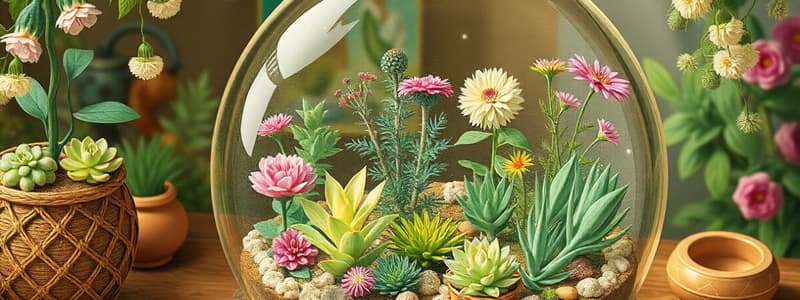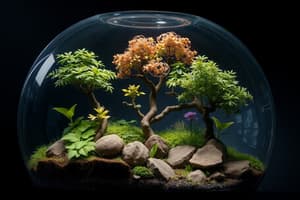Podcast
Questions and Answers
What was the original purpose of the invention of terrariums?
What was the original purpose of the invention of terrariums?
- To create a decorative home item
- To serve as a new agricultural method
- To grow all types of plants indoors
- To protect tropical plants during transport (correct)
Which material is NOT typically used as a filling in a terrarium?
Which material is NOT typically used as a filling in a terrarium?
- Drainage material such as rocks
- Sphagnum Moss
- Activated charcoal
- Cement (correct)
Which factor is NOT listed as a point to consider when selecting a terrarium container?
Which factor is NOT listed as a point to consider when selecting a terrarium container?
- Location
- Size of container opening
- Material type (correct)
- Color of glass
What is the main function of activated charcoal in a terrarium?
What is the main function of activated charcoal in a terrarium?
What should be avoided when installing plants in a terrarium?
What should be avoided when installing plants in a terrarium?
Which layer is applied directly over the gravel in the dish garden?
Which layer is applied directly over the gravel in the dish garden?
What should be considered when selecting plants for a dish garden?
What should be considered when selecting plants for a dish garden?
What is one reason container gardening has become increasingly popular?
What is one reason container gardening has become increasingly popular?
Which of the following is NOT listed as a suitable container for dish gardens?
Which of the following is NOT listed as a suitable container for dish gardens?
What is a common material used to increase drainage in a dish garden?
What is a common material used to increase drainage in a dish garden?
Flashcards are hidden until you start studying
Study Notes
Terrariums
- Invented by Nathaniel Ward in 1827, a London doctor, who discovered a way to keep plants alive in the polluted air of the city.
- Initially called "fern cases" then "Wardian cases".
- Used to transport tropical plants to protect them during sea voyages.
- Materials for terrariums include: drainage material, activated charcoal, sphagnum moss, figurines, sticks, and potting soil.
- Steps for preparing a terrarium:
- Place a layer of small gravel at the bottom.
- Sprinkle activated charcoal on top.
- Fill the terrarium with good draining potting soil.
- Install plants, leaving room for growth.
- Don't overwater the plants.
Dish Gardens
- Similar to terrariums but often use different types of plants.
- Containers for dish gardens include: bowls, cans, cartons, jars, logs, soup mugs, troughs, and other decorative items.
- Popular dish garden plants include: African violets, asparagus ferns, club moss, cobra lilies, Irish moss, jade plants, sundew, and Swedish ivy.
Container Gardening
- A practice as old as gardening itself.
- Gaining popularity in urban areas with limited space.
- Allows for creativity and self-expression.
- Types of containers include: ceramic, plastic, stone, terracotta, and timber.
- Different uses include: backgrounds, screens, decorations, hanging baskets, vertical walls, and window boxes.
Unusual Containers
- People are increasingly using interesting and unexpected containers for gardening.
- Examples: barrels, baskets, boots/shoes, buckets, growing bags, trays, tires, and wooden tubs.
Flower Arrangements
- An ancient art of organizing flowers and foliage according to design principles.
- Often used in: lounges, restaurants, receptions, banquets, lobbies, VIP rooms, and suites.
Principles of Flower Arrangements
- Balance is achieved when the flower size and container complement each other.
- Focal point is used to draw attention to specific areas, created by using unusual flowers, grouping flowers of one color, or using a larger flower.
- Proportion refers to the relative sizes of flowers and containers, aiming for balance and aesthetics.
- Scale considers the size of the flowers, placement, and the overall size of the arrangement in relation to the surrounding area.
- Accent is a point of interest to highlight the design.
- Repetition is used to emphasize flowers and colors by repeating certain materials or colors.
- Rhythm creates continuity amongst shapes, colors, and textures, giving a sense of motion.
- Harmony is created when all elements come together to create a cohesive and unified look.
- Unity is achieved when the arrangement flows together seamlessly, avoiding segmentation.
Design Materials for Flower Arrangements
- Line flowers create the framework of the arrangement (e.g., delphinium, gladiolus, snapdragons).
- Massing flowers fill in the design and enhance the focal point (e.g., asters, carnations, chrysanthemums, roses).
- Form flowers add unique shapes and forms (e.g., orchids, birds of paradise, protea).
- Filler flowers fill empty spaces (e.g., asparagus fern, baby's breath, huckleberry, heather, statice, palm).
Types of Flower Arrangements
- Triangular shape
- Circular shape
- Crescent shape
- Fan shape
- Hogarth or 'S' shape
- Ikebana
Creating Flower Arrangements
- Mechanics used to keep flowers in place: floral foam, chicken wire, pin holders, adhesive tape, setting clay, glue, pebbles/marbles.
- Equipment to create a good arrangement: buckets, florist scissors, misters, floral tape, wire, knives.
- Containers: vases, jugs, baskets, bowls, trays, wreath frames, candle cups, miscellaneous objects.
- Bases: wood, stone, oriental, tree section, table mats.
- Accessories: non-plant materials added for decoration (bronze lamps, hats, wooden shapes, beads, candles, carved objects, shells).
Bonsai
- A Japanese art of keeping trees dwarf in containers.
- Literally translates to “tree in a pot”.
- Ranges in size from under 12 cm to about 75 cm in height.
- Traditions date back over a thousand years.
- Similar practices exist in Chinese and Vietnamese cultures.
Characteristics of Plants for Bonsai
- Attractive bark or roots.
- Good twig form.
- Short internodes.
- Small leaves.
- Survive container culture.
- Survive intense pruning.
Plants Used for Bonsai
- Evergreen and deciduous species.
- Common plants: elm trees, fig tree (Ficus Bonsai), Fuchsia Bonsai, Jade Bonsai (Crassula), maple, olive Bonsai (Olea europaea), pine, pomegranate, and spruce.
Bonsai Techniques
- Styling involves:
- Trimming/cutting.
- Controlling branch shapes with wire.
- Using growth retardant.
Bonsai Styles
- Cascade
- Formal upright
- Informal upright
- Semi-cascade
- Slanting
Studying That Suits You
Use AI to generate personalized quizzes and flashcards to suit your learning preferences.




